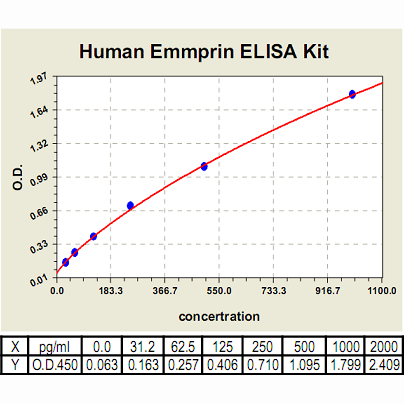Product Sheet CL0751
Description
BACKGROUND Extracellular MMP inducer( Emmprin; basigin;CD147) is a widely distributed cell surface glycoprotein that belongs to the Ig superfamily and is highly enriched on the surface of malignant tumour cells. In cells, CD147 is expressed in various forms, including high glycosylated (HG 45-65 kDa) and low glycosylated (LG 32-44 kDa) forms as well as the native 27-kDa protein. Emmprin is involved in numerous physiological and pathological systems and exhibits several molecular and cellular characteristics, but a major function of emmprin is stimulation of synthesis of several matrix metalloproteinases.1 In tumours, emmprin most likely stimulates matrix metalloproteinase production in stromal fibroblasts and endothelial cells as well as in tumour cells themselves by a mechanism involving homophilic interactions between emmprin molecules on apposing cells or on neighbouring cells after membrane vesicle shedding. Moreover, emmprin can also increase the urokinase plasminogen activating system in tumor and endothelial cells (ECs), further increasing its proteolytic potential. EMMPRIN is also implicated in lactate efflux, essential for tumor cell invasion, via its cotransporter MCT4. Indeed, the conversion of glucose to lactic acid in the presence of oxygen, generally known as aerobic glycolysis or Warburg effect, is uniquely observed in cancer and the excess generation of lactate that accompanies the Warburg effect needs to be exported from the cell. Furthermore, membrane-associated cofactors, including caveolin-1 and annexin II, regulate emmprin activity. Emmprin was found to stimulate tumor angiogenesis by elevating vascular endothelial growth factor (VEGF) and MMP expression in neighboring fibroblasts via the PI3K-AKT signaling pathway. Emmprin is also involved in multidrug resistance of cancer cells via hyaluronan-mediated activating of ErbB2 signaling and cell survival pathway activities.2 However, other functions of emmprin, including as an activator of T cells, a chaperone for monocarboxylate transporters, a receptor for cyclophilin A and a neural recognition molecule, are also being identified in physiological and pathological conditions. Therefore, it is essential to develop specific means to control particular functions of emmprin.3
REFERENCES
1. Nabeshima, K. et al: Pathol Int. 56:359-67, 2006
2. Gabison, E.E. et al: Biochimie. 87:361-8, 2005
3. Yan, L. et al: Thromb Haemost. 93:199-204, 2005
2. Gabison, E.E. et al: Biochimie. 87:361-8, 2005
3. Yan, L. et al: Thromb Haemost. 93:199-204, 2005
Products are for research use only. They are not intended for human, animal, or diagnostic applications.
Details
Cat.No.: | CL0751 |
Target Protein Species: | Human |
Range: | 31.2pg/ml-2000pg/ml |
Specificity: | No detectable cross-reactivity with any other cytokine. |
Storage: | Store at 4°C. Use within 6 months. |
ELISA Kits are based on standard sandwich enzyme-linked immunosorbent assay technology. Freshly prepared standards, samples, and solutions are recommended for best results.
Products
| Product | Size | CAT.# | Price | Quantity |
|---|---|---|---|---|
| Human Emmprin ELISA Kit: Human Extracellular MMP Inducer ELISA Kit | Size: 96 Wells | CAT.#: CL0751 | Price: $619.00 |

